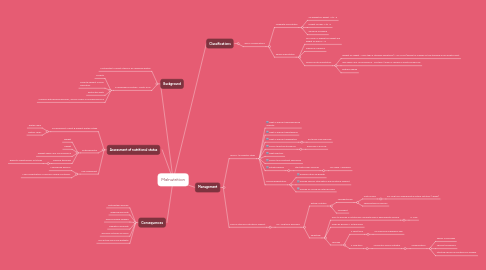
1. Background
1.1. Contributes to about a third of all childhood deaths
1.2. In developed countries- results from
1.2.1. Poverty
1.2.2. Parental neglect or poor education
1.2.3. Restrictive diets
1.2.4. Children with feeding disorders, chronic illness or anorexia nervosa
2. Classifications
2.1. WHO Classifications
2.1.1. Moderate malnutrition
2.1.1.1. SD weight for height -2 to -3
2.1.1.2. Height for age -2 to -3
2.1.1.3. Absence of edema
2.1.2. Severe malnutrition
2.1.2.1. SD Score for weight for height and height for age is <-3
2.1.2.2. Presence of edema
2.1.2.3. Severe acute malnutrition
2.1.2.3.1. Weight for height - more than 3 standard deviations (>-3 z-score) below tur median on the standard WHO growth chart
2.1.2.3.2. mid-upper-arm circumference - less than 115mm in children 6 month-5years old
2.1.2.3.3. bilateral edema
3. Assessment of nutritional status
3.1. Assessmment of past & present dietary intake
3.1.1. Dietary diary
3.1.2. Dietary recall
3.2. Anthropometry
3.2.1. Weight
3.2.2. Height
3.2.3. Weight-upper-arm circumference
3.2.4. Skinfold thickness
3.2.4.1. Reflects subcutaneous fat stores
3.3. Lab assessment
3.3.1. Low plasma albumin
3.3.2. Low concentration of specific mineral & vitamins
4. Consequences
4.1. Multisystem disorder
4.2. Impaired immunity
4.3. Wound healing delayed
4.4. Operative morbidity
4.5. Worsens outcome of illness
4.6. Less active and more apathetic
5. Management
5.1. WHO's 10 essential steps
5.1.1. Treat or prevent hypoglycaemia urgently
5.1.2. Treat or prevent hypothermia
5.1.3. Treat or prevent dehydration
5.1.3.1. But avoid fluid overload
5.1.4. Correct electrolyte balance
5.1.4.1. Especially K and Mg
5.1.5. Treat infection
5.1.6. Correct micronutrient deficiency
5.1.7. Initiate feeding
5.1.7.1. Start with small volumes
5.1.7.1.1. Too rapid = diarrhoea
5.1.8. During rehabilitation
5.1.8.1. Achieve catch-up growth
5.1.8.2. Provide sensory stimulation and emotional support
5.1.8.3. Provide for follow-up after recovery
5.2. Role of intensive nutritional support
5.2.1. For long term disorders
5.2.1.1. Enteral nutrition
5.2.1.1.1. Nasogastrically
5.2.1.1.2. Overnight
5.2.1.2. Parenteral
5.2.1.2.1. Aims to provide a nutritionally complete feed in approppriate volume
5.2.1.2.2. Given as glucose + fat emulsion
5.2.1.2.3. Through
